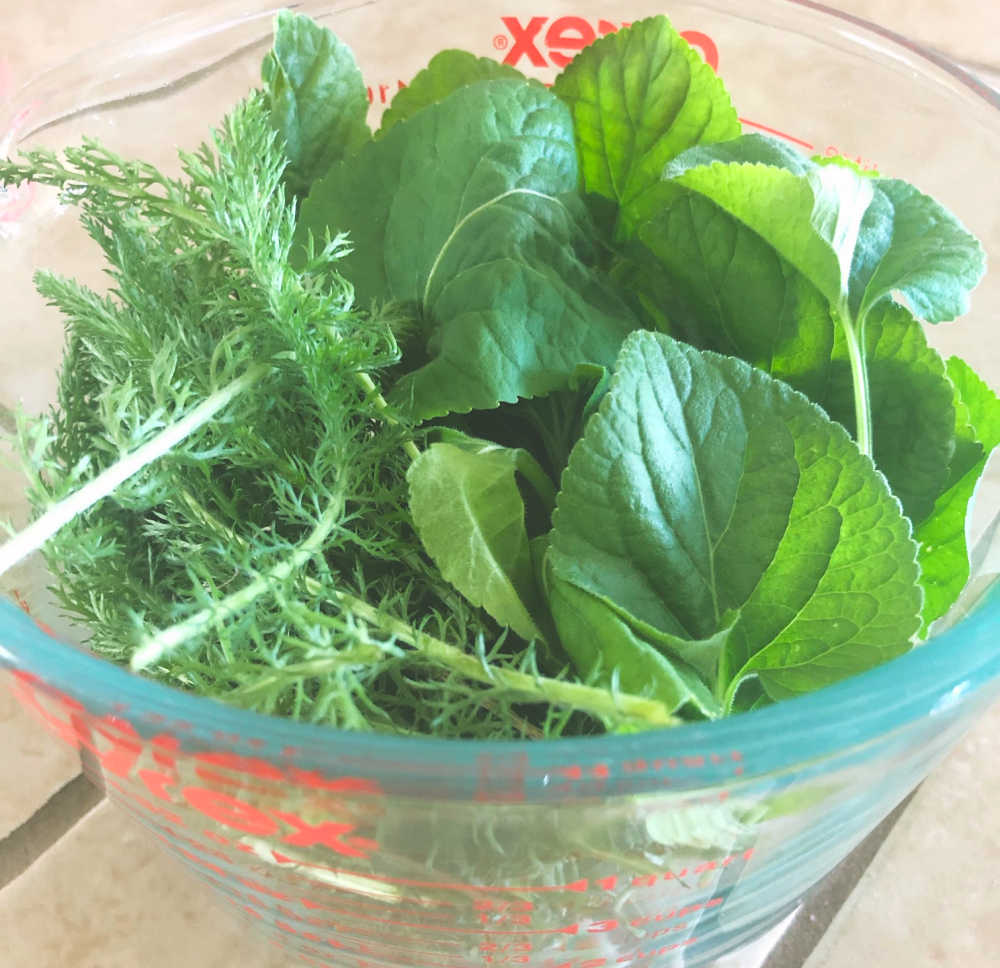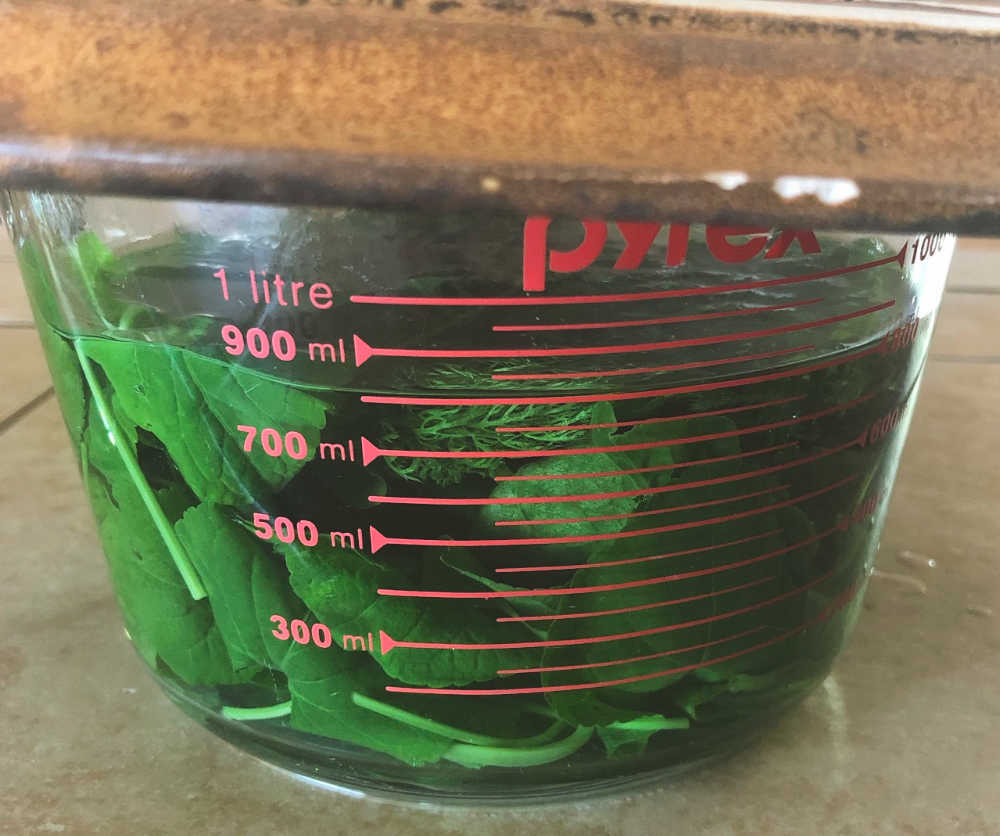Wild Violet and Yarrow Skin Soothing Natural Soap Recipe
There’s something so wonderful about creating handmade soaps using God’s gifts from the earth: clays, herbs, minerals, and more. This handmade soap recipe I tested with the hot process method includes skin loving wild plants I foraged right in our yard: wild violet and yarrow.
This lovely light-green soap smells divine, and you’ll love it’s skin soothing and healing qualities. The essential oils I chose for this handmade natural soap are fresh and clean!
I love simple soap recipes that yield a high quality homemade soap: nice and hard, a great lather with bubbles, yet still highly conditioning for the skin. This soap does not disappoint! It earns 5 stars in all areas!
About wild violets (Viola spp.) and why they’re great in this soap recipe
Wild violets, flowers and leaves, are filled with mucilage and skin soothing properties, making it perfect even for babies and those with sensitive skin. In fact, violets are one of the best lymphatic herbs you can forage! A lymphatic herb helps move the fluids through your body, preventing stagnation.
Violets are often used in creams for breast health because they are such a strong lymph system helper. At least a few herbalists I know touts them as being exceptional for cysts in the breast area. Violets are calming and soothing, and when used in soap like this, pass along their skin softening actions.
The energetics of violets are cool and moist.
About yarrow (Achillea millefolium) and why it’s fab in this recipe too!
Yarrow has so many amazing properties and actions, so I’ll address the topical ones here, since we are dealing with a soap recipe. Yarrow is an incredible anti-inflammatory herb, a minor bug repellant, and may even support hair follicle health.
Yarrow is astringent, meaning it tones the skin. It may even help soothe eczema and acne. It’s energetics are cool and dry, and these actions support toning the skin. One study claims yarrow may be instrumental in helping rejuvenate maturing and wrinkled skin!
I used the fresh green leaves of wild yarrow, as the flowers still haven’t bloomed on this early spring day where we are. I’m sure they helped give this soap its lovely light green color!
FTC Disclosure: There are affiliate links scattered throughout this article. If you click through and make any kind of purchase, I may earn a small commission at no extra cost to you.
You’ll love this FREE herbal remedy guide and cheat sheet! It’s 12 pages on 10 commonly found herbs and remedies you can start making today! Click here, and I’ll send yours along to you!
This wild violet and yarrow herbal handmade natural soap recipe is divine. There’s just no other word. It’s a beautiful light lime green color due to the herbs used, and it smells delicious. This hot process soap making recipe is perfect for your spring soaping days! #healingharvesthomestead #violet #yarrow #herbal #handmade #soap #hotprocess #howtomake #soaprecipe #naturalsoap #herbalsoap
Wild Violet and Yarrow Skin Soothing Soap Recipe
The ingredients for this moisturizing and conditioning soap recipe are simple. I used a tea of the yarrow and wild violets for the water portion of the recipe. It contains no added colorants, the light green color coming only from the plants.
The essential oils I chose for their calming qualities as well as the fact they are also helpful for skin health. You can omit the essential oils if you are looking for an unscented soap or if you have very sensitive skin.
NOTE: I’ve written this article with the assumption you know how to make hot process soap. If you are a beginning soap maker, no worries! Please read my complete soap making picture tutorials: How to Make Hot Process Soap (and a Citrus Dream Recipe) and my post on Lavender-Rosemary-Vanilla Hot Process Soap.
You’ll feel confident about making soap after going through those articles carefully. Also, if you want a very complete guide, take a look at this 98 page eBook: How to Make Hot Process Soap, which includes over 22 recipe variations, plus lists of natural colorants, textures, and other additives to play around with!
In all the sources above you can find information on the tools you’ll need, including safety gear. You’ll want to be sure to wear eye protection, gloves, and long sleeves when handling lye or caustic soap.
Check out our herbalism school: The School of Botanical Arts & Sciences! From short to longer intensive courses, there’s something for you here!
Ingredients for Wild Violet & Yarrow Soap
The Oil Mixture:
15 ounces organic olive oil
9 ounces coconut oil (I purchase both the olive oil and coconut oil from Costco, as I’ve found their prices are lowest.)
6 ounces avocado oil (Also from Costco, although the link is for Amazon)
2 ounces castor oil
The Lye Solution:
12.16 ounces violet & yarrow tea
4.5 ounces sodium hydroxide (lye)
Essential Oils (Optional):
1 ounce Lavender essential oil
1 ounce Spearmint essential oil
NOTE on essential oils: The links above are for Amazon, but I buy my essential oils for soap making only from Starwest Botanicals. This is because I can save a bit of money by buying in larger quantities from them. Also, I feel the quality of their oils is generally far better than most brands on Amazon.
Starwest is also a great place to buy all of your herbal and natural body needs, as well as your culinary spices!
Learn to make your own handmade soap with an emphasis on the hot process method! You’ll never go back to buying soap again! Click for more information.
I used fresh herbs for the tea. You can see I had quite a few to create some color.
Directions for Making Your Herbal Soap:
1) Make your herbal tea for the water portion
Make your herbal tea by placing fresh wild violet leaves and flowers as well as yarrow leaves in a Mason jar about 3/4 full. If you are using dried herbs, fill the jar about half full. You may not get the same color as I did if you use dried herbs, but you’ll still have the skin loving effects!
2) Measure out your oils
Measure your oils and put them in the crock pot set to low. Allow them to melt completely.
3) Create your lye solution
Get your lye solution going. First, strain the plant matter from the tea. Measure out the amount of tea you need. Be sure your tea is cooled to at least room temperature, as you don’t want a lye volcano, which can happen if you pour lye into already hot water.
Pour your lye into the cooled liquid. Stir well until it’s all combined.
Here is the tea steeping. I always put a cover on my steeping teas, even for soaps so as not to lose the volatile oils.
4) Combine the oils and lye solution
Carefully pour the lye solution into the melted oils.
5) Bring the mixture to trace
Using your hand blender, stir for around five minutes or so until the mixture reaches trace. This will be like a good pudding texture. You can see pictures in the links above.
6) Cook on low
Simply cook on low in your crockpot and stir occasionally until it’s finished! You can find out how to tell when your soap is done in the links above.
7) Add essential oils (optional)
At this point, you stir in your essential oils for scent.
8) Put your soap in the soap mold
Since this is a hot process soap recipe, you’ll not “pour” your soap, as it will be thick and feel kind of waxy. Instead, you’ll “glop” it into the mold using a wooden spoon. I know of no other way to describe this! Press the soap down well into the mold so you don’t end up with air pockets.
9) Cool your soap
Allow your soap to cool down completely before removing it from the mold, or you’ll have a mess. Plus, it may still be hot in the middle. I like to let mine cool down overnight so it’s nice and hard.
10) Remove the soap from the mold
Now you can remove the soap! It will be a nice loaf or block of soap that you can cut as you need or all at once. You can certainly use your soap right away, too! This is one of the benefits of hot process soap over cold process: you can use it a lot faster since it needs no actual curing time.
You may notice your soap feels a little moist and perhaps even a tad soft. This didn’t happen with this recipe for me, but every soap making session is different. The humidity in the air can even affect your soap!
If this is the case, allow your soap to sit for one to five days, and you’ll see a big difference. Allowing it to sit for a day or so allows any extra moisture to evaporate.
You can read about the differences between hot process and cold process soap here if you like.
And that’s it! :-)
This recipe yields two pounds of beautiful, high lather, moisturizing and conditioning soap.
Final Thoughts on Wild Violet & Yarrow Skin Soothing Natural Soap
Out of all the things I no longer buy at the store any more, herbal soaps are one of my favorite things to make in this self reliant journey we are on. I just love them. Homemade soaps made with natural ingredients are so very good for your skin and health.
I’ve even had friends tell me they don’t even need lotion or moisturizer any more after using my soap recipes! Saves money! Saves time. Saves your health. Triple score!
This recipe is a new one, and I really like it. The fatty acid profile is perfect for a cleansing, yet highly conditioning bar of beautiful herbal soap.
Let me know if you try it!
You might also enjoy these other articles:
18 Necessities I Never Buy at the Store Anymore, and What I Do Instead
The Best Essential Oils for Scenting Handmade Soap Naturally
Make Your Own Cling Wrap, and Go Plastic Free
Mango-Avocado Anti-Aging Soap Recipe
There are lots more over on the website, and I hope you’ll go browse around!
Hugs, Health, and Self-Reliance,
Heidi
P.S. Don’t forget to sign up for the newsletter and you’ll never miss a thing! You’ll also get immediate access to the Resource Library, where you’ll find eBooks, guides, and more to help you in your journey to self-reliance, including my Hot Process Soap Making Checklist!
I love this recipe, and I can hardly wait til next spring to make some more! By the way, if you don’t have springtime violets, you can substitute with calendula!
Ready to make your own natural handmade soap using herbs and essential oils? This wild violet and yarrow soap recipe will delight you and your friends. Makes a great Mother’s Day or other gift! Because it’s a hot process recipe, it cures super fast and will be ready right away! It can be adjusted for cold process too. #soapmaking #recipes #forbeginners #natural #handmade #soap #ideas #essentialoilsfor #easy #diy #hotprocess #coldprocess #healingharvesthomestead
References:
https://articles.mercola.com/herbs-spices/yarrow.aspx
Young, D., The Backyard Herbal Apothecary. Page Street Publishing. 2019.












